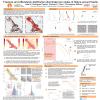Poster #162, Fault and Rupture Mechanics (FARM)
Surface Displacement and Ground Motion from Dynamic Rupture Models of Thrust Faults with Variable Dip Angles and Burial Depths
Poster Image:

Poster Presentation
2020 SCEC Annual Meeting, Poster #162, SCEC Contribution #10749 VIEW PDF
es from 20° to 70° and burial depths from 0 to 5 km. We conduct rupture models on these geometries embedded in a homogeneous half-space, using different stress drops but fixed frictional parameters, and with homogeneous initial stresses versus stresses tapered toward the ground surface. Ground motions decrease as we bury the fault under homo-geneous initial stresses. In contrast, under tapered initial stresses, ground motions increase in blind-thrust faults as we bury the fault, but are still the highest in emergent faults. As we steepen dip angle, peak particle velocities in the homogeneous stress case generally increase in emergent faults but decrease in blind-thrust faults. Meanwhile, ground motion consistently increases with steepening dip angle under the stress gradient. We find that varying stress drop has a considerable scalar effect on both ground motion and permanent surface displacement, whereas changing fault strength has a negligible effect. Because of the simple geometry of a planar fault, our results can be applied to understanding basic behavior of specific real-world thrust faults.
SHOW MORE
SHOW MORE























































